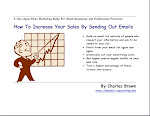This is the big dilemma for companies who need to produce and market white papers. The natural choice to write your company's white papers would seem to be an engineer or technical person with an understanding of the nuances of the product or service being presented.
However, at the risk of gross generalization, insiders have a notoriously difficult time breaking free of their field's jargon, which they need to communicate with their peers. The same technical language that helps them do their work, makes it hard to make difficult concepts understandable for outsiders.
Certainly there are many engineers, lawyers or other highly specialized people who are excellent writers and communicators, but they are in the minority.
On the other hand, an outside writer may have difficulty mastering the technical concepts that are at the heart of a white paper. Those of us who were English majors chose our field for a reason. That reason being we wanted to steer as far away from the science and engineering fields as we could.
There are, however, ways for the non-technical writer to grasp and communicate even the most difficult concepts to the average reader.
- First, the writer needs strong interviewing skills. A good interviewer can coax layer upon layer of information out of anyone. In this regard, the white paper writer is like a journalist who must become a minor expert on a lot of topics in order to report on them to the general public.
- Next, the writer must develop good research skills. I never go into an interview without first doing as much research as I can on the topic I will be writing on. The more knowledge I have acquired beforehand, the better questions I can ask during the interview, and the clearer my final white paper will be.
- The non-technical person doesn't assume some facts are obvious. On several occasions I have had the opportunity to teach workshops or classes on various subjects. Interestingly, when I personally had difficulty learning the subject matter, I was better able to teach it. Why? Because I had to work hard to learn the material and therefore I knew what areas could be misunderstood or confusing.
- The writer should look for the "stories" involved with a product. What problems did an actual customer face before using the product and how did it solve those problems afterwards? What challenges did the research and development team face and overcome in the process of developing the product? These stories are the building blocks for excellent case studies that can be used in the final white paper.
- The writer must not lose sight of the fact that a white paper is, first and foremost, a persuasive document. Technical details come in second to influencing the reader to take action. The best way I know to persuade is to find out what the reader wants and show them how to get it. This means anticipating every possible question and every possible objection and crafting a compelling response to each one.
- Finally, the writer as an outsider is better able to distinguish features from benefits. It's an old story, but to insiders, the mere mention of the "XYZ widget with its turbo booster conductor coil" means fuel economy. But the outsider who is always willing to withstand rolling eyeballs and ask, "What does the XYZ widget with its turbo booster conductor coil do?" can learn and communicate the fact that this device will save the customer 35% of its annual fuel costs.
Obviously, there is no absolute right answer to the question of whether a technical insider or a non-technical writer / outsider is better able to write a quality white paper. Situations vary and there are advantages to either choice. So examine your options and take a hard look at your needs and the talent you have available for the project.
COPYRIGHT © 2008, Charles Brown

Labels: white papers



0 comments:
Post a Comment